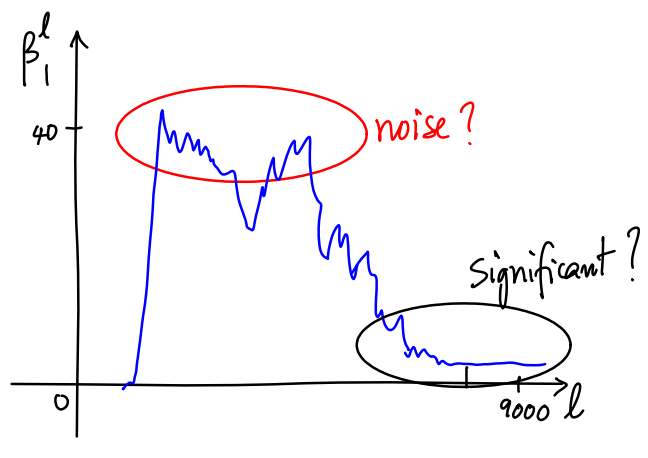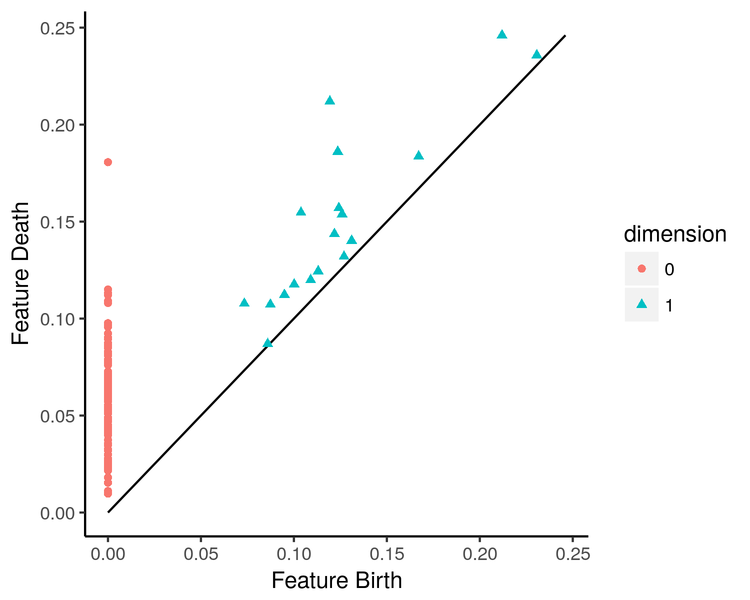Consider a filtration on a simplicial complex :
Then we can consider the homology group of each subcomplex in the filtration:
As a result we also get the Betti numbers
Notice that the inclusion map , , induces the homomorphism .
Persistent Homology Group
The p-persistent k-th Homology group of is given by
and is the p-persistent k-th Betti number of .
In other words, are all -cycles in that are not -boundaries in (note ).
We can gather information on the complex by tracking for fixed and varying . For example,

in the plot above we see early on there are a lot of holes (recall represents the number of holes) in the complex that get “filled” later on. However, initially there is a lot of noise. We expect any significant feature of the space to have a long “lifetime”. In otherwords, we want to look for cycles in that are not boundaries until for some time step .
Assume that the non-boundary -cycle is created at time with the inclusion of simplex . Then . Assume that at time , becomes a -boundary with the inclusion of simplex , that is, the hole captured by is closed by . Then and the class is merged with an older class of cycles.
Persistence and Lifetime
Let be a non-boundary -cycle. If is created by at time , then is the creator of . If is destroyed by at time , i.e., merges with an older class, then is the destroyer of . We say is the lifetime of and that the persistence of is .
Some classes may not have a destroyer. In such a case, its persistence is .
Fundamental Lemma of Persistent Homology
Our goal is count the number of classes that are born in and die in . Notice that represents the number of classes in that are still alive in . As result, the number of classes that are alive in but die entering is given by
Similarly, the number of classes alive in K^j$ is given by
Therefore,
is the number of p-dimensional classes that are born at and die entering .
Fundamental Lemma of Persistent Homology
Persistence Diagrams
We pair a creator with a destroyer to capture a specific -dimensional class. The persistence diagram is formed by taking all such pairs and plotting their indices on the index-index plane.

Under the assumption that we have a monotonic filtration (all proper faces already exist when enters), then we get that for all pairs.
So we say the persistence is the vertical distance from the line. We can use persistence diagrams to calculate the persistent Betti numbrs:
is given by the number points (with multiplicities) in the upper left quadrant with corner .
We can compute the pairings using the “combined boundary matrix”.
Combined Boundary Matrix
Let be a monotonic filtration. We construct the matrix by
The matrix captures the filtration in the order of rows and columns. We will use replacement column operations over to “reduce” the matrix.
low, reducedLet be the row index of the lowest 1 in column j. We call a matrix reduced if whenever for non-zero columns of .
The reduction algorithm moves through columns left to right, adding any columns to the left of where .
void REDUCE
R = combined boundary matrix
for j=1 to m
while there is some j'<j such that low(j)=low(j')
add column j' to column j
end
end
end
This algorithm is quite slow with run time of .
After the reduction is finished, the pairings are given by for non-zero columns .